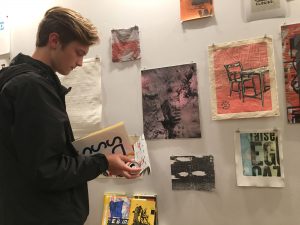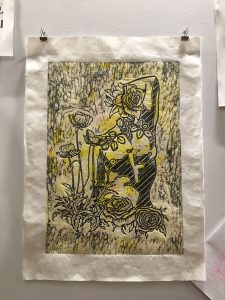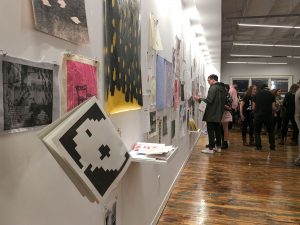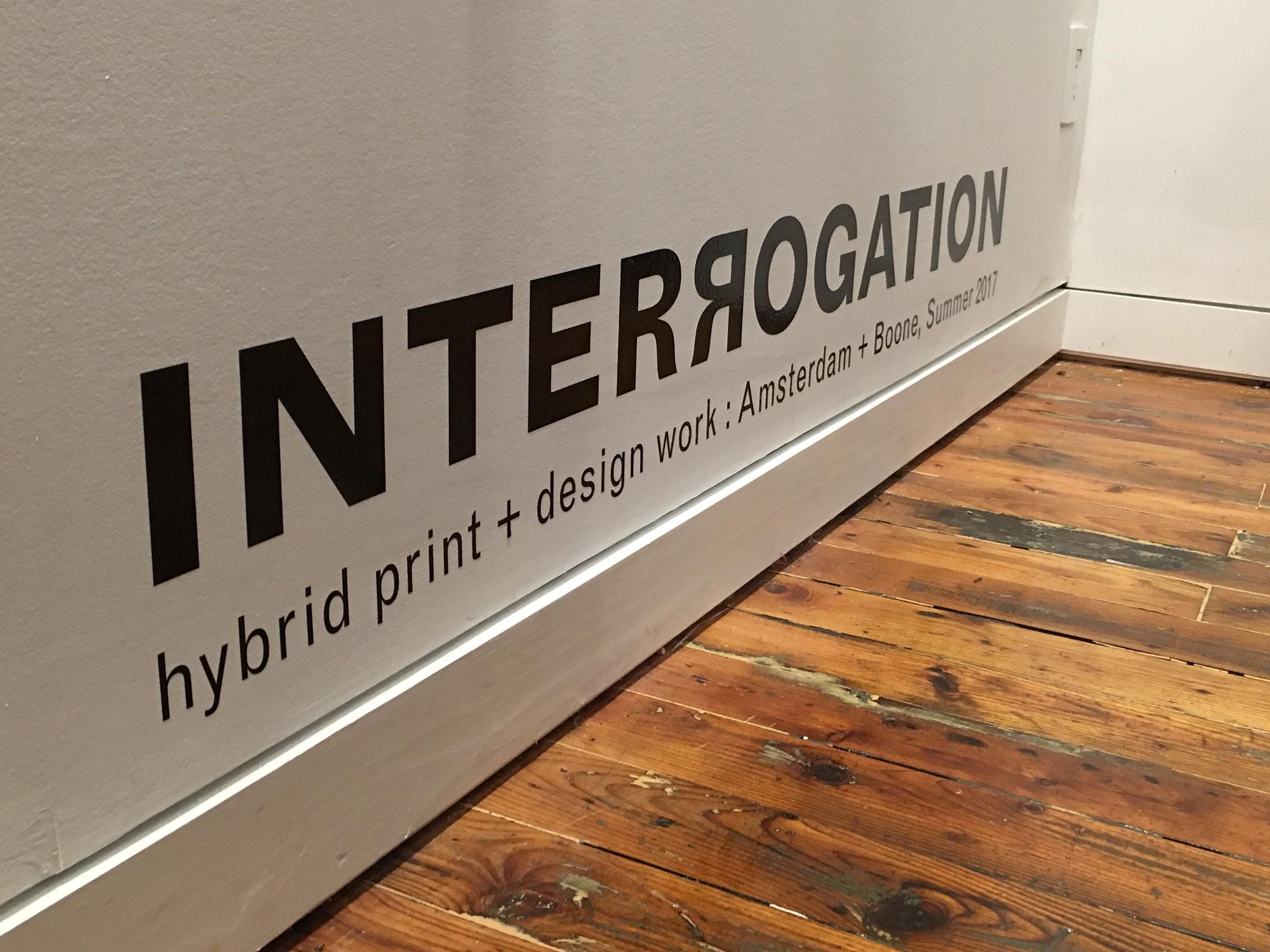After two and a half weeks exploring and creating in Amsterdam, 12 graphic design and printmaking students came together on Sept. 1 to celebrate the opening of their exhibition “Interrogation,” which combined elements of print and design in a fusion project presented at HOW Space.
The students’ study abroad experience, led by professor Scott Ludwig and assistant professor Tricia Treacy, focused on collaboration and tied in digital, letterpress, printmaking and risograph techniques.
Treacy and Ludwig, who teach graphic design and printmaking, respectively, created the program as a way to bring students together and connect differing mediums with similar themes and techniques.

Some students had proficiency in both printmaking and graphic design, but for the most part, the students had experience on only one side of the collaboration. By connecting with artists from different backgrounds, the students had to explore new methods of creation and combine them with the skills they already knew.
Senior graphic design major Alex Amaya went into the program with a design focus, but found similarities between graphic design and printmaking. Letterpress, for example, is a style within printmaking, but is also much like typography as it is studied in graphic design. Whether an artist is coming in with printmaking or graphic design experience, Amaya said, the end focus is still on designing a piece of art.
Although most of their days were spent working in studios, the students also spent time exploring art and design within Amsterdam, whether through examining local architecture and infrastructure or visiting the city’s art museums.
Senior graphic design and philosophy major Philip Crowther chose the arts’ influence on Amsterdam as the focus of his work during the trip.
“It’s interesting seeing how other places can work the arts into the infrastructure of their society,” Crowther said. “Just going around the Netherlands, you can see that art is a bigger part of their day-to-day lives, in how the streets are planned, the amount of public arts there, the architecture– everything seems more planned out and considered than it does in the United States.”

Further, the resources available in Amsterdam made the city an appealing location for printmaking and design studies. The students spent much of their time working in two studios: Grafisch Werkcentrum Amsterdam and Amsterdam Grafisch Atelier. GWA’s letterpress had some of the largest wood type and lead type collections in Europe, and Ludwig’s connections after a 2012 residency in Amsterdam helped accommodate the class during their trip.
Belle Hissam, a senior studio art major, used the studios’ resources to delve into new techniques and tools. Her visit to Amsterdam was the first time Hissam had the opportunity to use a letterpress; the equipment is something that Appalachian State does not yet have. Hissam said she was excited to have access to such older, uncommon heavy machinery, which she said was up to 50 or 60 years old.
Much of the students’ time was spent in these printmaking studios, studying new methods while using equipment they did not have access to at home. Hissam said the students were working in the studios from 8 a.m. to 6 p.m. most days.
Senior graphic design major Abby Piette tried to embrace the trip’s long hours.
“It was challenging and inspiring,” Piette said. “It was kind of a rollercoaster because it was a productive trip; we went abroad not just as tourists but as artists. We were working in the studio while we were abroad, which was a really special experience that not a lot of study abroad opportunities might have.”
To focus their collaborative efforts during the trip, the artists were given a single word to study: “interrogation.”
“We tried to create something that was open ended but also had some tension,” Treacy said.
The theme was narrow enough to help unify the students’ work, but their adaptations of the word branched off in entirely unique directions. Their first responses to the word were somewhat typical and mostly negative, like thoughts about police interrogation. After the group brainstormed together, however, new perceptions of “interrogation” came to light.
“We came up with the term interrogation, but it just became so much more,” Ludwig said. “We did this word association and filled the whiteboard with hundreds of words to stimulate the idea that this has relationships to a greater scheme.”
Each student took the theme of interrogation to mean something different. Amaya studied interrogation and manipulation within modern dystopian societies. Crowther focused on interrogating the infrastructure of society as it relates to art. Hissam studied authorities’ interrogation of minors and false confessions; her art created sensations of anxiety and stress using blurry, chaotic images and incriminating phrases like, “Do you know what you did wrong?”
Piette’s vision of interrogation evolved through her time in Amsterdam. She embarked on the trip studying interrogation in everyday life, drawing on common phrases like, “How are you?” and acknowledging the depth or superficiality of those questions’ answers. As her trip came to a close, however, her perception changed.
While editing photographs taken in the city, Piette would zoom in with extreme focus on tiny details, trying to edit colors or cover things up. This would eventually become the new focus for her look at interrogation.

“I noticed that I really liked the extreme crops,” Piette said. “In a way, it felt like I was interrogating the photographs I took, looking at super close details that were invisible from their full size. I started to look at interrogation as in paying attention to details– even beyond editing a photograph, just details in life.”
Piette then focused on other small details, creating collages to express minute feelings such as the sensation of listening to a song from your childhood, or the image of a bus stop sign’s shadow passed onto the ground.
Though all 12 students were working with the same word, it seemed that each student took an entirely different approach. Through collaboration and discussion, the artists were able to tie each unique definition of interrogation into one exhibit, exploring the versatility of the word, which Ludwig described as “multivalent.”
The exhibit, which features a combination of prints, books and video, will be open for viewing at HOW Space, located on Howard Street, until Sept. 14.
Story By: Ashley Goodman, Associate A&E Editor
Photos By: Caroline Moss, Intern Photographer

